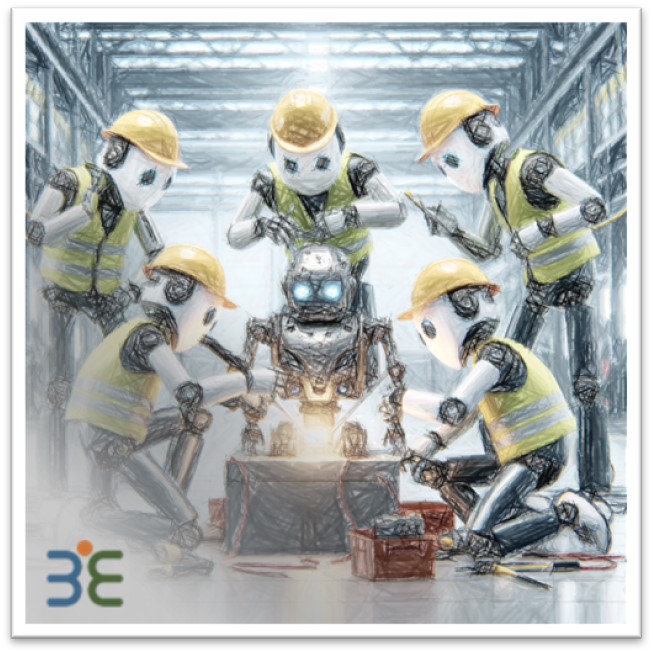
Robotic Process Automation (RPA) require services and maintenance, to uphold the ongoing efficiency, reliability, and effectiveness of automated tasks and processes within an organization.
Similar to any other technology, regular and predictive maintenance is essential to anticipate and prevent issues before they occur, including updating software, checking for bugs, and optimizing processes to enhance performance. Maintenance ensures that RPA processes adhere to regulations and standards. Regular updates address security vulnerabilities, safeguarding sensitive data and systems from potential threats. Predictive combined with proactive maintenance mitigates costly downtime caused by bot failures or inefficiencies, resulting in savings of time and resources in the long run.
RPA Automation Services
Why Maintenance?
Similar to any other technology, regular maintenance is essential to anticipate and prevent issues before they occur. This involves updating software, checking for bugs, and optimizing processes to enhance performance. Regular maintenance facilitates the optimization of RPA by analyzing bot performance and identifying areas for improvement, thereby enhancing efficiency and productivity. Maintenance also ensures that RPA processes adhere to regulations and standards, regular updates address security vulnerabilities, safeguarding sensitive data and systems from potential threats.
How to Perform Maintenance?
Regularly monitor bot performance, tracking metrics like execution time, error rates, and resource usage to identify and address any issues or areas for improvement. Keep RPA software and bots up to date with the latest patches and updates to ensure compatibility and address security vulnerabilities. To conduct regular testing of RPA processes, including both automated and manual testing, ensures they are functioning as expected in terms of accuracy and reliability. And don’t forget to maintain documentation of RPA, including workflows, configurations, and dependencies, which is valuable for troubleshooting issues and onboarding new team members.
And what to Include in Maintenance?
For example a regularly review of RPA bot code to identify potential issues or inefficiencies, or ensuring adherence to best practices and ease of maintenance, also implementing robust error handling mechanisms to detect and resolve errors during bot execution, including logging errors, retrying failed tasks, and alerting operators to potential issues. Important is to monitor resource usage, such as CPU and memory utilization, to ensure that bots are not consuming excessive resources, optimizing bot configurations as needed to improve efficiency. As for any other system, services including to Implement backup and recovery procedures to protect against data loss in case of bot failures or system crashes, regularly testing backup procedures to ensure effectiveness.
How reducing the escalating costs of maintaining and supporting RPA?
The costs of maintenance and support of RPA systems has become a pressing concern for businesses, according to a study, half of RPA projects fail to achieve their objectives, with one major contributing factor being the significant level of maintenance and support required for in-production bots. Even without concrete quantitative evidence, experiences across industries indicate widespread struggles with RPA management. Constant cycles of fixing bot errors lead to substantial maintenance costs, hindering the anticipated return on investment and impeding broader business objectives such as cost reduction, efficiency improvement, and process quality enhancement.
To understand the challenges of automation teams and RPA Centers of Excellence in maintaining and supporting RPA, it’s essential to identify why bots break!
Bots face challenges when the user interface (UI) of the applications they interact with changes. Take, for example, a bot streamlining invoice processing, if the input field in the ERP system relies on getting updated, errors may arise. Regulatory shifts, policies and process change, data- or technical environment also pose hurdles, updates and changes, or controls can affect bots, leading to increased maintenance costs. Establishing a solid RPA management and governance model becomes even trickier when changes emerge or existing ones evolve.
Even seasoned automation teams and RPA Centers of Excellence (CoEs) can miss requirements during development.
To tackle RPA maintenance challenges head-on, a proactive design approach is key, shifting from reactive to proactive RPA management can significantly slash downtime and maintenance expenses. A comprehensive and AI supported design strategy is essential. in providing developers with precise guidelines upfront and detailing all dependencies can prevent many maintenance issues and system outages predictively.
RPA Automation Services
Bots maintaining Bots, or what is AI-Enhanced Predictive Maintenance for RPA Systems?

Robotic Process Automation (RPA), in fusion of Artificial Intelligence (AI) with augmented and predictive maintenance services is revolutionizing how organizations uphold the efficiency and reliability of their automated processes.
Augmented Intelligence, an integration of artificial intelligence (AI) capabilities with human intelligence to enhance predictive decision-making and proactive problem-solving, designed to complement and amplify human capabilities of automation teams and RPA Centers of Excellence, enabling individuals to make more informed decisions and perform tasks more efficiently, to conduct regular reviews of SLA performance with stakeholders and management, identifying any breaches or areas for improvement and taking better corrective actions. Embracing AI-enhanced predictive maintenance and services, organizations can ensure the reliable and efficient operation of their RPA processes and bots while meeting business objectives and exceeding customer expectations.
Automated and AI capabilities can improve 24/7 support to offer round-the-clock services to address any technical issues, inquiries, or concerns related to RPA implementation and operation. Automated monitoring and alarming of predictions is providing ongoing proactive maintenance services and ensuring the optimal performance of RPA bots, including regular updates, error handling, and performance monitoring with low failure and downtime.
AI managed RPA Services is orchestrating the maintenance and services tasks of RPA infrastructure and processes to units or a third-party provider, who takes responsibility for day-to-day operations, maintenance, and performance optimization. Augmented AI continuously evaluating and optimizing automated processes to improve services and support efficiency, accuracy, with providing insights and analytics on RPA bot performance, process metrics, and efficiency to support data-driven decision-making and continuous services improvement efforts.
Examples of automated maintenance and services tasks, AI-enhanced predictive maintenance, monitoring, tracking and reporting.
- Leverage advanced AI-powered monitoring tools to track bot performance, status, and overall health in real-time.
- Implement intelligent alert systems that utilize predictive analytics to identify and notify of potential issues such as bot failures, performance degradation, or system errors before they occur.
- Automate routine maintenance tasks such as software updates, database cleanup, and system optimizations using cutting-edge tools.
- Employ predictive maintenance algorithms to schedule proactive maintenance activities based on historical data and patterns, optimizing system performance and preventing potential issues.
- Establish an incident management process powered by AI algorithms to swiftly address bot failures or errors. Utilize ticketing systems for efficient tracking and prioritization of incidents.
- Utilize AI-driven change management processes to track and manage changes to RPA processes and configurations. Implement version control systems to effectively manage bot code and configurations.
- Leverage platform-specific tools for centralized management, scheduling, and monitoring of RPA bots.
Monitoring Tools - Utilize AI-powered monitoring tools for comprehensive log management, analysis, and visualization of key metrics and logs.
- Harness automation tools for continuous integration, deployment automation, and configuration management to streamline maintenance processes.
- Define maximum response times for addressing incidents or bot failures, ensuring timely resolution. For instance, aim to respond to critical incidents within 1 hour during business hours.
- Set target resolution times for resolving incidents or issues to minimize downtime. For example, resolve critical incidents within 4 hours during business hours.
- Define minimum uptime requirements for RPA processes or bots to ensure consistent availability, aim to ensure RPA processes are available 99% of the time during business hours.
- Define performance metrics such as bot execution time, error rates, and throughput to measure and optimize system performance, maintain bot execution time under 5 minutes for critical processes.
- Monitor SLA compliance using advanced metrics and reports from monitoring tools, leveraging dashboards in tools or custom reports to track SLA metrics.
- Generate regular SLA reports to track performance and identify areas for improvement, including metrics such as SLA compliance, incident response times, and uptime.
At BestExperts we aim to emerge as your business initiator and sales enabler, specialized on tech startups or technology players entering new markets. Within our assessment and initiative program, we are prioritizing a strong foundational pipeline and drive partner opportunities, evaluating the potential for a mid-term-plan in the first months to success, protecting ventures and driving business initiatives.

